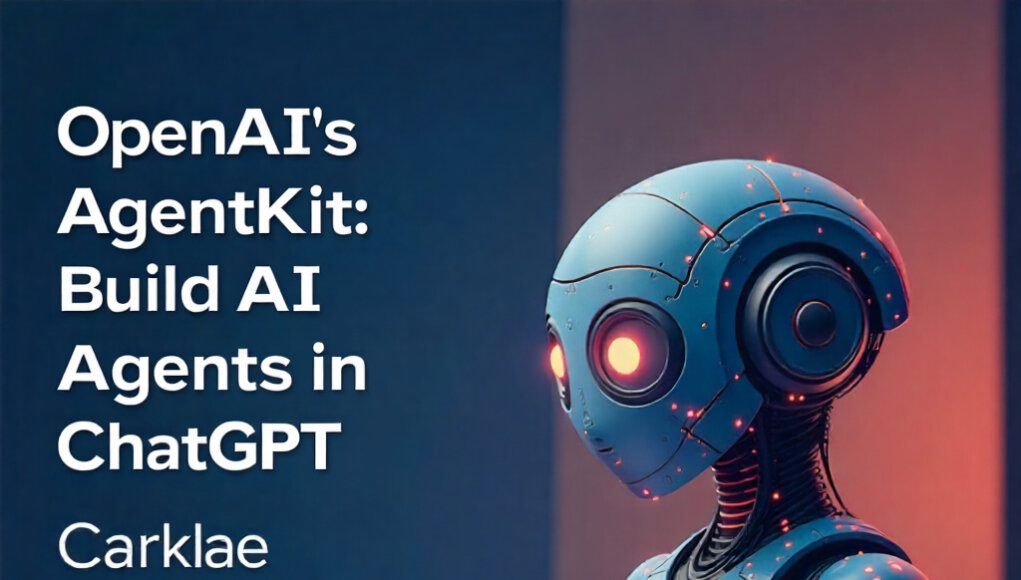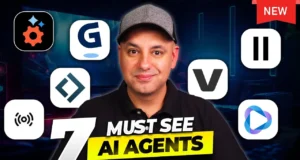Breaking news just dropped, and it’s kind of a big deal: OpenAI just silently launched one of its most significant updates in months. At their Dev Day event, CEO Sam Altman announced AgentKit, a complete toolkit designed to help developers take agents from prototype to production with way less friction.
OpenAI’s AgentKit: Build AI Agents in ChatGPT
This isn’t just another incremental update, this is OpenAI making a serious play to democratize AI agent creation and put the power of automation directly into developers’ hands. If you’ve been waiting for an easier way to build full agents and automations inside ChatGPT, your wait is officially over.
What Exactly Is AgentKit? (And Why Should You Care)
Here’s the thing: AgentKit is everything you need to build, deploy, and optimize agent workflows, all packaged into one comprehensive platform. Think of it as OpenAI handing you a complete construction kit for building intelligent automation systems. Instead of cobbling together different tools and platforms to create AI agents, you now have a unified ecosystem that handles everything from design to deployment.
The launch signals OpenAI’s push to increase developer adoption by making agent building faster and easier, and represents a competitive move against other AI platforms racing to offer integrated tools for building autonomous agents that can perform complex tasks beyond just responding to prompts. This is OpenAI saying “we’re not just about chat anymore—we’re about action.”
How to Access AgentKit Right Now (Step-by-Step)
Ready to try this out yourself? Here’s exactly how to get started:
Step 1: Navigate to platform.openai.com (not the regular ChatGPT interface—this is the developer platform)
Step 2: Look for the “Build with AgentKit” button in the middle of your screen and click it
Step 3: Click “Open Agent Builder” to launch OpenAI’s visual agent creation tool
Step 4: You’ll now see the Agent Builder interface with all your tools on the left side and a full automation sequence canvas in the middle where you can design workflows from left to right
From here, you can either create your own workflow from scratch or choose from pre-built templates to get started faster. The interface is visual and intuitive—Altman described it as “like Canva for building agents,” a fast, visual way to design the logic, steps, and ideas.
The Four Core Capabilities That Make AgentKit Powerful
AgentKit includes a few core capabilities that work together to create a comprehensive agent-building ecosystem:
1. Agent Builder: This is your visual design studio. It’s built on top of the Responses API that hundreds of thousands of developers already use, which means if you’re already familiar with OpenAI’s developer tools, you’ll feel right at home. You can drag, drop, and connect different components to create complex agent workflows without writing tons of boilerplate code.
2. ChatKit: This provides a simple embeddable chat interface that developers can use to bring chat experiences into their own apps. Want to add AI chat functionality to your product? ChatKit lets you bring your own brand, your own workflows, whatever makes your own product unique while leveraging OpenAI’s powerful backend.
3. Evals for Agents: Here’s where things get really professional. This introduces tools to measure AI agent performance, including step-by-step trace grading, datasets for assessing individual agent components, automated prompt optimization, and the ability to run evaluations on external models directly from the OpenAI platform. You’re not just building agents—you’re measuring and improving them systematically.
4. Connector Registry: AgentKit includes access to OpenAI’s connector registry, so developers can securely connect agents to internal tools and third-party systems through an admin control panel while maintaining security and control. This is crucial for enterprise applications where security and compliance aren’t optional.
Is This Too Complex for Non-Developers? (Probably Not for Long)
Let’s be real: this update was specifically made for developers. If you’ve never built an AI agent or automation before, it might look intimidating at first glance. The interface has multiple panels, workflow sequences, and technical terminology that assumes some coding familiarity.
But here’s the interesting part: the fact that OpenAI is making this developer-focused tool so visual and user-friendly suggests something bigger is coming. This feels like OpenAI testing the waters and gathering feedback before releasing a much simpler, more accessible version for regular ChatGPT users. Think about it—ChatGPT has hit 800 million weekly active users, and giving even a fraction of those users the ability to create their own AI agents would be transformative.
To prove how accessible they’re trying to make this, Christina Huang, an OpenAI engineer, built an entire AI workflow and two AI agents live onstage in under eight minutes. Eight minutes. That’s faster than most people can order food delivery.
What Can You Actually Build with AgentKit?
The possibilities are genuinely exciting. Here are some practical use cases you could build right now:
Customer Support Automation: Create an agent that can handle common customer inquiries, escalate complex issues to humans, and learn from interactions to improve over time. Use ChatKit to embed this directly into your website with your branding.
Research Assistants: Build agents that can search multiple sources, synthesize information, fact-check claims, and compile reports—all while you focus on higher-level analysis.
Workflow Automation: Design agents that can monitor your email, extract action items, create calendar events, update project management tools, and send status reports without human intervention.
Content Generation Pipelines: Create multi-step workflows where one agent researches topics, another drafts content, a third edits and optimizes, and a fourth publishes according to your schedule.
Data Analysis Tools: Build agents that can pull data from multiple sources, run analyses, generate visualizations, and present insights in formats tailored to different stakeholders.
The Competitive Landscape: Why OpenAI Made This Move
This isn’t happening in a vacuum. The launch signals a competitive move against other AI platforms racing to offer integrated tools for building autonomous agents for enterprises. Companies like Anthropic, LangChain, and various startups have been building agent frameworks, and OpenAI clearly doesn’t want to cede that territory.
By creating an all-in-one platform that handles agent building, deployment, evaluation, and integration, OpenAI is betting that developers will choose convenience and integration over best-of-breed point solutions. It’s a smart play—developers are always looking for ways to reduce complexity and consolidate their toolchain.
What This Means for the Future of AI Automation
Here’s what excites me most about AgentKit: “This is all the stuff that we wished we had when we were trying to build our first agents,” Altman said. OpenAI is literally building the tools they wish they had when they started, which means they’re solving real pain points from firsthand experience.
The trajectory is clear: AI is moving from conversational interfaces to agentic systems that can take action autonomously. AgentKit is OpenAI’s bridge between those two paradigms. Right now, it’s for developers. Soon, it’ll likely be for everyone. The fact that they’re starting with robust, professional-grade tools suggests they’re building a foundation that can scale to millions of users creating their own custom agents.
If you’re a developer, now’s the time to experiment with AgentKit and get ahead of the curve. If you’re not technical, keep watching—the simplified version is almost certainly coming, and it’s going to change how we all interact with AI. The age of passive chat is ending. The age of active AI agents is just beginning, and OpenAI just handed developers the keys to build it.





